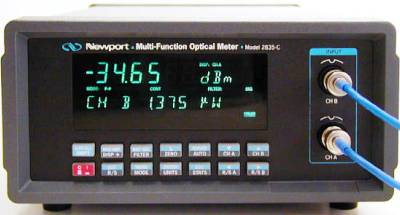
|
|
The Newport 2835-C Dual-Channel High-Performance Optical Meter is compatible with Newport’s low-power 818-series, highpower 818P-series and energy 818E-series detectors, allowing both free-space and fiber pigtailed measurements in the 190–1800 nm range. When using one of these detectors with the 2835-C, a calibration module needs to be attached to the detector, assuring the correct reading at any selected wavelength. DC, peak-to-peak and pulse measurements can be displayed in units of W, dBm, dB, J, Ergs, A, and V. Simultaneous measurements of a variety of light sources operating at different power levels and wavelengths can be performed with our dual-channel 2835-C optical meter. Low-power measurements, in the 100 fW–2 W range, can be accomplished with any one of Newport’s 818 Series silicon, germanium or indium gallium arsenide semiconductor detectors, covering 190–1800 nm wavelengths. High-power measurements, in the 20 mW–300 W range, can be performed with Newport’s 818P and 818T Series thermopile detectors, enabling measurements in the 0.19–11 µm wavelength range. Energy measurements of pulsed laser sources, from 50 mJ–1 J, can be taken with Newport’s 818E and 818J Series family of pyroelectric detectors, operating in the 0.19–20 µm wavelength range. Pulse repetition rates from single shot to 2 kHz can be accommodated. Advanced features include a 2500 data point storage buffer; analog and digital filtering; programmable sample rates; moving statistics; and up to 10 recallable configurations. Specifications. Display Type: 6-digit vacuum fluorescent. Sampling Resolution: 20,000 count <=25 Hz, 4096 count <=1 kHz. Gain Ranges: 7 decades. Current Sensitivity (full-scale): 2.5 nA to 2.5 mA. Voltage Sensitivity (full-scale): 790 µV to 25 V. Resolution: 100 fA, 125 nV. Sampling Rate: Up to 1 kHz single-channel, Up to 500 Hz dual-channel. Bandwidth (-3 dB): DC to 1 MHz(1). Analog Output: 0 to 2.5 V into 50 ohms. DC Accuracy: < ±0.1% typical. Peak-to-Peak Accuracy: ±1% typical. Pulse-to-Pulse Accuracy: ±1% typical. Integration Accuracy: ±1% typical.
|